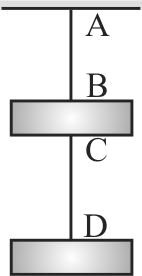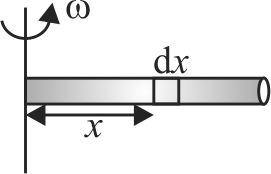354836
A uniform string of length \(l\), mass \(M\) rotates about one of its end \(O\) in a horizontal plane with an angular speed \(\omega\). You can ignore force of gravity on the string. The time taken by a transverse wave pulse from one end of the string to another i.e., \(O\) is \(\dfrac{\pi}{\sqrt{x} . \omega}\). The value of \(x\) is
354837
Two blocks each having a mass of \(3.2\;kg\) are connected by a wire \(CD\) and the system is suspended from the ceiling by another wire \(AB\). The linear mass density of the wire \(AB\) is \(10gm/m\) and that of \(CD\) is \(8gm/m\). The ratio of wave speeds in strings \(AB,CD\) is \(\sqrt{\dfrac{8}{x}}\). The value of \(x\) is
354836
A uniform string of length \(l\), mass \(M\) rotates about one of its end \(O\) in a horizontal plane with an angular speed \(\omega\). You can ignore force of gravity on the string. The time taken by a transverse wave pulse from one end of the string to another i.e., \(O\) is \(\dfrac{\pi}{\sqrt{x} . \omega}\). The value of \(x\) is
354837
Two blocks each having a mass of \(3.2\;kg\) are connected by a wire \(CD\) and the system is suspended from the ceiling by another wire \(AB\). The linear mass density of the wire \(AB\) is \(10gm/m\) and that of \(CD\) is \(8gm/m\). The ratio of wave speeds in strings \(AB,CD\) is \(\sqrt{\dfrac{8}{x}}\). The value of \(x\) is
354836
A uniform string of length \(l\), mass \(M\) rotates about one of its end \(O\) in a horizontal plane with an angular speed \(\omega\). You can ignore force of gravity on the string. The time taken by a transverse wave pulse from one end of the string to another i.e., \(O\) is \(\dfrac{\pi}{\sqrt{x} . \omega}\). The value of \(x\) is
354837
Two blocks each having a mass of \(3.2\;kg\) are connected by a wire \(CD\) and the system is suspended from the ceiling by another wire \(AB\). The linear mass density of the wire \(AB\) is \(10gm/m\) and that of \(CD\) is \(8gm/m\). The ratio of wave speeds in strings \(AB,CD\) is \(\sqrt{\dfrac{8}{x}}\). The value of \(x\) is
354836
A uniform string of length \(l\), mass \(M\) rotates about one of its end \(O\) in a horizontal plane with an angular speed \(\omega\). You can ignore force of gravity on the string. The time taken by a transverse wave pulse from one end of the string to another i.e., \(O\) is \(\dfrac{\pi}{\sqrt{x} . \omega}\). The value of \(x\) is
354837
Two blocks each having a mass of \(3.2\;kg\) are connected by a wire \(CD\) and the system is suspended from the ceiling by another wire \(AB\). The linear mass density of the wire \(AB\) is \(10gm/m\) and that of \(CD\) is \(8gm/m\). The ratio of wave speeds in strings \(AB,CD\) is \(\sqrt{\dfrac{8}{x}}\). The value of \(x\) is
354836
A uniform string of length \(l\), mass \(M\) rotates about one of its end \(O\) in a horizontal plane with an angular speed \(\omega\). You can ignore force of gravity on the string. The time taken by a transverse wave pulse from one end of the string to another i.e., \(O\) is \(\dfrac{\pi}{\sqrt{x} . \omega}\). The value of \(x\) is
354837
Two blocks each having a mass of \(3.2\;kg\) are connected by a wire \(CD\) and the system is suspended from the ceiling by another wire \(AB\). The linear mass density of the wire \(AB\) is \(10gm/m\) and that of \(CD\) is \(8gm/m\). The ratio of wave speeds in strings \(AB,CD\) is \(\sqrt{\dfrac{8}{x}}\). The value of \(x\) is

